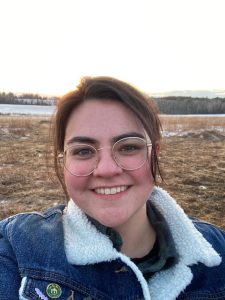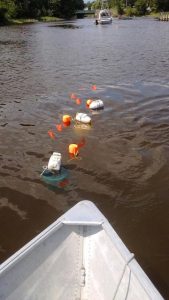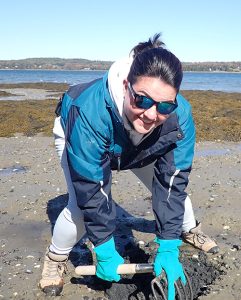Mudflat meets world: Hillyer’s research reaches a global audience
 PhD student Gabby Hillyer discusses her innovative research in midcoast Maine at an international conference
PhD student Gabby Hillyer discusses her innovative research in midcoast Maine at an international conference
By Nate Poole
Gabby Hillyer has been a member of the University of Maine community going on seven years, and for approximately five of those years she has been telling and re-telling a story about a stolen bucket.
“The bucket drifter story is one that has been told a lot in my tenure here,” Hillyer said, laughing.
Hillyer is a Ph.D. student in the Ecology and Environmental Sciences program at UMaine. She also participates in the National Research Traineeship Program in Conservation Science and serves as the project coordinator for the Maine Shellfish Learning Network (MSLN), a novel partnership that connects harvesters and others from up and down Maine’s coast to better address the multifaceted issues facing their shellfisheries. Both the MSLN and her graduate research on the coast of Maine emerged from her involvement with an organized effort to strengthen coastal economies at the Senator George J. Mitchell Center for Sustainability Solutions. Hillyer has a robust list of accomplishments on her resume, but the bucket drifters always seem to float to the top.
A “bucket drifter” is a GPS-equipped five-gallon bucket designed to drift with the tides, allowing researchers to trace tidal flows and the pollutants potentially carried therein. Hillyer designed the low-tech device to address the needs of clammers in Waldoboro who were struggling to stave off pollution-fueled mudflat closures along the Medomak River. Her design considered the capacity and budget needs of her community partners, and, to top it all off, they actually worked. That was until one drifter mysteriously disappeared. The response from the Waldoboro community was swift and serious: clammers, the town manager, and police came together and located and retrieved the stolen bucket.

The story of the stolen bucket drifter is a classic tale of a small Maine community rallying to address a problem that might seem mundane in another town, but it also represents the kind of community buy-in and trust that researchers across disciplines are increasingly seeking out with their own projects. This is part of the reason the story of Hillyer’s bucket drifters has taken on a life of its own, and why, when tasked with putting together an article on the benefits of community-university partnerships, researchers with the Senator George J. Mitchell Center for Sustainability Solutions sought to share Hillyer’s story once again.
“Is it the perfect story? Probably not, but it’s a really good start, where people begin to understand what [community-engaged] work looks like,” Hillyer said.
Getting buckets of attention
In November 2022, the article, “Collaboration on the Mudflats: How community-university partnerships can strengthen deliberative and democratic practices,” was published in Issues in Science and Technology, co-authored by David Hart, Bridie McGreavy, Anthony Sutton, Darren Ranco, and Hillyer. Soon after, a professional contact that Hillyer made while attending the 27th United Nations Climate Change Conference (COP27), read the article and immediately recommended Hillyer to the chair of an international conference held in mid-January. The conference was hosted by the Institute for Latin American Studies (ILAS) at Hankuk University of Foreign Studies (HUFS) in Seoul, South Korea, a research center dedicated to addressing ecological and environmental crises through the study of Latin America.
Having read “Collaboration on the Mudflats,” the chair invited Hillyer to speak alongside a group of scientists that all engage communities and partners in their research in different ways. In her presentation, Hillyer discussed her research with the Mitchell Center and MSLN, and touched on some of the key takeaways from her work with the Waldoboro community. In particular, she shared insights about what it takes to build trust with community partners and the vital importance of listening to their needs before anything else. She said that while the presentation was relatively short, the discussion with the audience members afterward yielded some fascinating conversations. Questions emerged about the importance of the bucket drifters as objects over which both the researchers and the community partners had authority, while others focused on the way that tidal models reveal that rivers like the Medomak don’t exist in a vacuum, but are rather connected with and dependent on ecosystems both near and far.
“It was a very interesting trajectory from COP[27], to long conversations via email, to this publication that really summarized so much of the work that I wanted to do, to a presentation in front of an international audience,” she said.
RFB: Requests for Buckets
 Despite her passion for involving community members in the research process, until she began her graduate studies at UMaine, Hillyer hadn’t spent much time developing what she refers to as “basic life skills” in an academic environment.
Despite her passion for involving community members in the research process, until she began her graduate studies at UMaine, Hillyer hadn’t spent much time developing what she refers to as “basic life skills” in an academic environment.
“There just wasn’t a lot of that relationship building that was happening and continues to happen in the work that me and my advisors and many others at the Mitchell Center do,” she said.
Thanks to her work in Waldoboro, Hillyer now understands the level of respect and care that it is necessary for a researcher to approach partnerships that involve people’s livelihoods. She said that trust is the result of making commitments to community members and following through. Whether it was picking up the phone at 5:00 AM to answer a harvester’s questions or driving to Waldoboro in the middle of the night because the tide is perfect for deploying the bucket drifters, her good-faith effort ultimately yielded not one, but two major projects.
After conducting her research on the Medomak River, word made its way up the coast to the next major shellfishery, and Hillyer started hearing from harvesters in Thomaston.
“It’s been really, really cool to see how conversations between harvesters up and down the coast are going, ‘What’s going on with those buckets? What do we have to do to get some buckets in our river?’”
It wasn’t long before Hillyer was also deploying bucket drifters in the Georges River estuary with Dr. Lauren Ross, who is also serving on her dissertation committee. She said that one of the amazing rewards of community-engaged research is that the outcome is not just a publication; community members want to continue to work with the researchers, which leads to other communities reaching out to get involved and reap the same benefits. In addition to supporting this research with grants and technical assistance, Hillyer said that the Mitchell Center’s staff and faculty fellows, like her Ph.D. advisor, Dr. Bridie McGreavy, have been essential by introducing her to the history and nuances of research that involves and centers the needs of diverse partners.
“[The Mitchell Center] is like a little community of people that I’m able to bounce ideas off of, that I’m able to talk with and learn from. It’s been awesome,” she said. “None of the work that I do would be functional without the kind of people that are at the Mitchell Center.”
Less than two months away from defending her dissertation, scheduled for April 20 at 9 AM at the Mitchell Center, Hillyer said that going forward she wants to continue to support “communities that are on the ground, that are trying innovative and adaptive techniques that you may not see anywhere else.”
She can only hope that her next innovation finally eclipses the bucket drifter.
